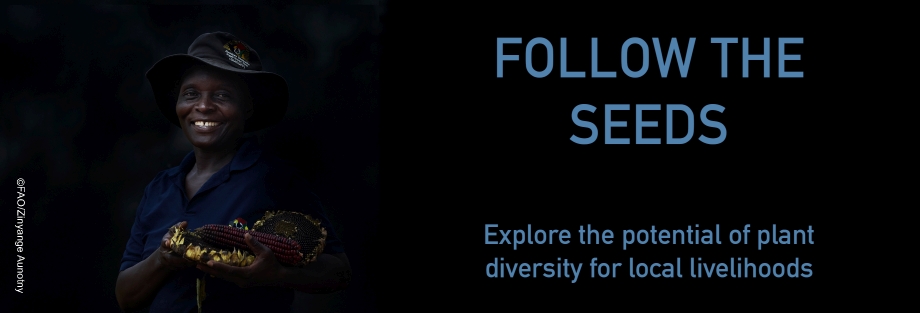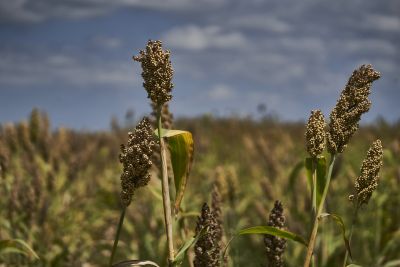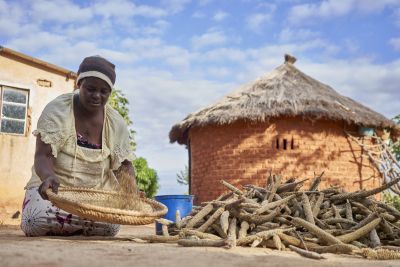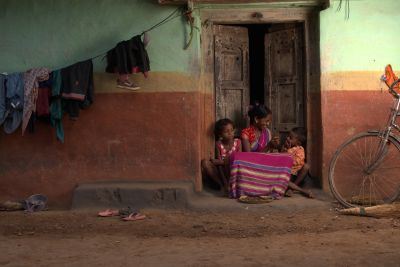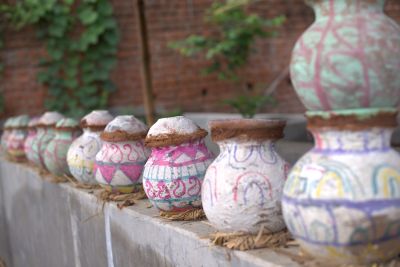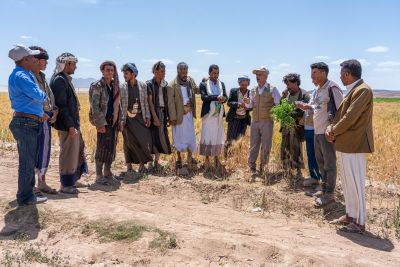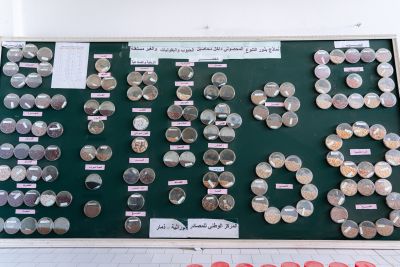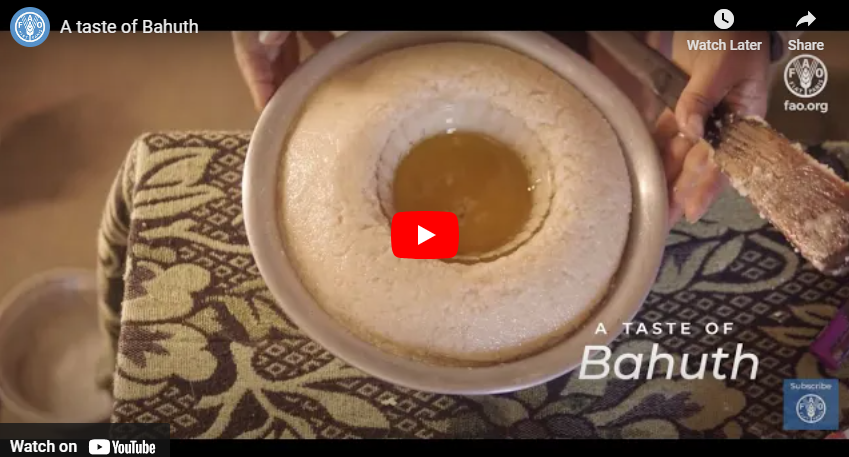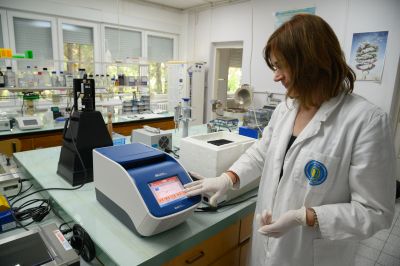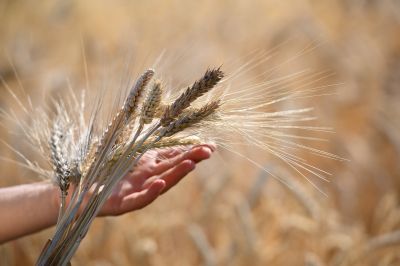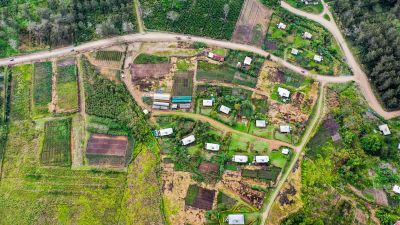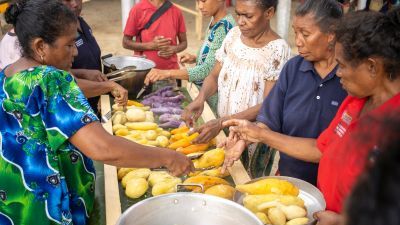Follow the Seeds
Rediscovering small grains - Zimbabwe, Africa
Rediscovering small grains - Zimbabwe, Africa
|
|
credits: ©FAO/Zinyange Auntony | |
Millets and other small grains
Farmers in Southern Africa are rediscovering the importance of crops such as millet, sorghum, peas and groundnut. These crops have strong potential to thrive in hard conditions, especially in areas prone to drought. Farmers are, once again, turning to them to improve self-sufficiency, diversify their sources of income, and to reap the nutritional benefits.
Various actors in the region are working together to introduce, test and develop resilient varieties of small grains and other crops. More than 5 000 plant genetic materials have been evaluated by farmers and scientists to identify the best-performing cultivars for further breeding and improvement. The projects funded by the Benefit-sharing Fund are not only increasing the availability of diverse quality seeds for these adapted crops, but are also promoting sustainable farming practices.
Zimbabwean farmer Analyce Chidembo and her husband experienced the advantages of millet, when maize failed dismally due to poor rains: “We planted our stored pearl millet seeds. Millet matures in about ten to twelve weeks, which is quick. That is a huge advantage I see in small grains. I think more people will turn to these grains to help fight hunger now that the climate changes.”
Chidembo began cultivating millet after participating in a Benefit-sharing Fund project several years ago. In 2024 she will join a second phase of the project as lead farmer, guiding Farmer Field Schools in her area. The implementing partner Community Technology Development Trust works alongside the Government of Zimbabwe, who has adopted the organization’s Farmer Field Schools approach into government extension services.
Return to forgotten crops - India, Asia
Return to forgotten crops - India, Asia
|
|
credits: ©FAO/Pankaj Paul | |
Millets, oilseeds and pulses
Over the past two decades, communities in central and eastern Indian states had largely abandoned the cultivation of oilseeds, pulses and small grains such as millet. This has led to loss of crop variability and the knowledge of how to grow them. The decline in their cultivation has contributed to serious malnutrition and loss of genetic diversity in the area.
Recently, farmer Pudi Soren started growing these crops again, using seeds she received from one of the five community seed banks supported by the International Treaty’s Benefit-sharing Fund. She values the many advantages that millet brings her. “We can grow finger millet in the rice fallow season and summer, and some cow dung is sufficient as fertilizer. Millet is a good source of protein in our meals, and my children like the biscuits that I make with the flour.”
Soren advocates for the saving, sharing and caring of seeds such as millet, which may have been forgotten, but are of global importance. In September 2022, she addressed the plenary session of the International Treaty in India, where 150 countries and more than 600 experts were present. She stressed the significance of reviving the use of forgotten seeds and having access to crops that grow well locally.
A return to forgotten crops and the conservation and promotion of underutilized species, such as millet, taro, oilseeds and pulses is a trend in more countries in Asia. Research and breeding institutions in the region are testing plant genetic materials that have the potential to be nutrient-dense and climate-resilient, while being profitable and adapted to local conditions.
Improving seed security in areas of conflict and emergency - Yemen, Near East
Improving seed security in areas of conflict and emergency - Yemen, Near East
|
|
credits: ©FAO/Omar Alobidy | |
Wheat
The Fertile Crescent forms a so-called centre of diversity, domestication and origin of essential crops such as legumes and cereals – crops that are important on a global scale. In the region, national research centres, gene banks and universities have joined forces for the collection, documentation, evaluation and breeding of farmers’ varieties of barley, chickpea, faba bean, sorghum, lentil and wheat.
The farmers’ varieties provide a reservoir of genetic diversity that is essential for crop improvement and for supporting crop adaptation to stresses. More than threatened 500 landraces of 20 species have been collected and safeguarded at a time of conflict. These plant genetic materials are evaluated and documented, together with traditional knowledge of farming practices associated with these varieties.
Farmer Wardah Mus’d Hasan cultivates wheat and participates in agricultural training in a project in Yemen. “I live in Dhamar and our area suffers from drought. On top of that, the ongoing war in Yemen has led to horrible food crises. Since my participation in the project, I started cultivating new varieties of wheat. I prefer Bahuth 3, an improved wheat variety that we received from the national gene bank.”
The project reintroduced landraces of strategic crops in farmers’ fields. In a follow-up project, the National Genetic Resource Centre in Yemen plans to expand the network of community seed banks across the country, to enhance the flow of genetic diversity among farmer communities and support local seed development.
Preserving the local food heritage - Serbia, Europe
Preserving the local food heritage - Serbia, Europe
|
|
credits: ©FAO/Victor Sokolowicz | |
Wheat
Small-scale farmers in Albania, Bulgaria and Serbia have witnessed a shift in the moderate, continental climate that they were used to. Intense heatwaves, less rainfall and sudden heavy downpours leading to flooding have affected the yield stability of regional staple crops such as wheat and barley. The changing climate forces farmers to reconsider the plant varieties that they grow.
Research institutes, gene banks and farmers have joined forces to find and improve crop varieties that are resilient to extreme weather events. At the same time, they are focusing on varieties that respond to market demand for varieties with higher nutritional value and fewer food allergens. This sometimes calls for a revival of varieties that were lost to most farmers.
One example is a wheat variety that was brought to the attention of FAO’s food hero Sanja Mikic by a local farmer. Mikic’s team at the Serbian Institute of Field and Vegetable Crops studied the sample and found that it was Banatka, a variety that used to be grown in parts of Serbia and neighbouring countries. Its flour is of superior quality, and perfect for the traditional fine pastries that are part of Serbia’s food heritage. But the downside is that the plant has a very long stem and tends to collapse with heavy rain and wind. For this reason, Banatka had been largely replaced by modern varieties and has disappeared from farmers’ fields.
The institute has now multiplied and disseminated Banatka and other varieties for testing in farmers’ fields. At the same time, breeders are using the material to develop a new variety with a shorter and stronger stem, while preserving Banatka’s valued qualities. Mikic believes that “it is important to keep all these diverse genetic resources and use them to develop new varieties that can tackle challenges of climate change that we are facing now, and will surely face in the future.”
The project has contributed to global-level conservation of crop varieties that are important to the region. Varieties of wheat, rye, barley and oats were gathered during collection missions or retrieved from gene banks. These important seeds have now been safely duplicated in the Svalbard Global Seed Vault, as part of the Benefit-sharing Fund project.
A shift in staple crops - Papua New Guinea, Southwest Pacific
A shift in staple crops - Papua New Guinea, Southwest Pacific
|
|
credits: ©FAO/Russell Wai | |
Sweet potato
Banana, taro, coconut and sweet potato are part of Southwest Pacific island culture. They provide an essential source of food and nutrition, as well as a regular income for local people. The importance of these crops and the responsibility to conserve them, both in farmers’ fields in genebanks, are a shared concern of countries in the region.
While banana, taro and coconut originate from the Pacific islands – and some of these crops’ varieties are unique to the region – sweet potato was first domesticated in Central and Southern America. The crop was introduced to Papua New Guinea about 300 years ago. The adoption of sweet potato brought several advantages, including its ability to thrive at higher altitudes than, for example, taro. With sweet potato cultivation, people could base themselves more permanently on higher land.
The crop’s popularity is still on the rise on the island, with a range of varieties that grow well under various agricultural conditions. A project supports the conservation of sweet potato varieties in diversity plots maintained by farmer communities throughout this Pacific nation. As part of this initiative, the National Agricultural Research Institute has successfully assembled 170 genetic types of sweet potatoes and has selected 60 for further evaluation.
Gibson and Geno Gabi from Rigwali used to be primarily dependent on banana and coconut. Since their participation in the project they have diversified, to include varieties of sweet potato. They work together with researchers on improvement of the crop. First, they select the most promising genetic lines, and after harvesting the tubers, they select the potatoes that best match their desired traits. Gibson Gabi said that “sweet potato has become our main cash crop and we can sell higher volumes than we could with bananas. We are still learning new cultivation practices to increase the quality and our yield.”
On seeds and stories - Video installation
On seeds and stories - Video installation
Seeds are stories that sprout in the telling – they encapsulate the clues that determine their traits and values. And with seeds come knowledge about their management and their conservation.
As seeds hold stories, they are part of stories – entangled together with our roots, our natures and our histories. They appear in poetry, folk tales, songs of the land and songs of longing of a place once known. Think of the expressions with seeds in languages, with seeds of change, of endurance, of despair and of hope.
Seeds and the food coming from the seeds play an often deep-seated role in traditions – to mark important events and rituals, such as sowing, harvesting, welcoming, and saying farewell. But while seeds travel around the world, traditions are much more deeply grounded in a geographical place – linking the seeds to the role they play in co-existing with the environment.
•••
Muyu Raymi, or seed festival in Kichwa, is an initiative of the Union of Peasant and Indigenous Organizations of Cotacachi (UNORCAC), based in Ecuador. The idea blossomed when some of the women were talking about the varieties of seeds they knew and saw the need to show and share the valued traits that each of these provided.
A small group of women saw the idea growing stronger over time. Women from other associations, producer organizations and nearby institutions now take part in the festival. “Muyu Raymi is like the celebration of a great party, expressed through a market gathering,” said one of the UNORCAC presidents, Magdalena Fueres.
Each year, around 300 women producers participate in this great party. They present their seeds and describe the multiple benefits. The festival is organized in August, prior to the sowing season. Producers exchange their seeds, that come from different areas close to and far from the market in Cotacachi. Besides seeds, visitors can exchange and buy fresh and healthy food products and enjoy the gastronomy of the region. The relevance of the initiative reaches far, as the region is a biodiversity-rich hotspot for food plants that are important for humanity.
•••
In Usurufa, Papua New Guinea, Irate is a traditional method of making fire. It has been passed down through generations. By lighting the fire, people light up the highlands to symbolize the value in which they hold their culture and tradition, promising to impart their traditional knowledge to future generations.
Lighting this fire is the start of a cooking method known as ‘highlands mumu’. First, stones are heated in a firepit, with grasses on top. When the stones are blazing hot, hollow sticks of bamboo are placed in the middle of the pit, filled with leafy vegetables, lamb ribs and herbs. Besides bamboo sticks, sweet potatoes and other tubers are laid on the stones and covered with greens. Banana leaves, and even bags with soil are used to completely cover the food and the pit, preventing the steam from escaping. Water is then poured into the pit from the sides, to increase the formation of steam. After two or three hours, all the leaves are removed, and the food is ready to serve.
Les graines sont des histoires qui germent dans le récit – elles renferment des indices qui déterminent leurs traits et leurs valeurs. De même, les graines sont accompagnées de connaissances sur leur gestion et leur conservation.
Étant donné que les graines contiennent des histoires, elles font partie des récits – liés à nos racines, à notre nature et à nos histoires. Elles apparaissent dans la poésie, les contes populaires, les chants de la terre et les chants de nostalgie d’un lieu autrefois connu. Pensez aux expressions se référant aux graines dans les langues, porteuses de graines de changement, d'endurance, de désespoir et d'espoir.
Les graines et la nourriture qui en provient jouent un rôle souvent profondément ancré dans les traditions: pour marquer des événements et des rituels importants, tels que les semailles, la récolte, l'accueil et les adieux. Mais même si les graines voyagent à travers le monde, les traditions sont bien plus profondément ancrées dans un lieu géographique – liant les graines au rôle qu’elles jouent dans la coexistence avec l’environnement.
….
Muyu Raymi, ou festival des semences en Kichwa, est une initiative de l'Union des organisations paysannes et autochtones de Cotacachi (UNORCAC), basée en Équateur. L'idée a germé lorsque certaines femmes ont parlé des variétés de graines qu'elles connaissaient et ont compris la nécessité de montrer et de partager les caractéristiques appréciées que chacune d'elles offrait.
Un petit groupe de femmes a vu l’idée se renforcer au fil du temps. Des femmes d'autres associations, organisations de producteurs et institutions voisines participent désormais au festival. « Muyu Raymi est comme la célébration d'une grande fête, exprimée à travers un rassemblement de marché », a déclaré l'une des présidentes de l'UNORCAC, Magdalena Fueres.
Chaque année, environ 300 productrices participent à cette grande fête. Elles présentent leurs semences et en décrivent les multiples bienfaits. Le festival est organisé en août, avant la saison des semailles. Les producteurs échangent leurs semences, qui proviennent de différentes zones proches et éloignées du marché de Cotacachi. Outre les graines, les visiteurs peuvent échanger et acheter des produits alimentaires frais et sains et profiter de la gastronomie de la région. La pertinence de l’initiative va loin, car la région est un hotspot riche en biodiversité pour les plantes alimentaires importantes pour l’humanité.
Las semillas son historias que brotan al contarlas: encierran las claves que determinan sus rasgos y valores. Y con las semillas vienen los conocimientos sobre su gestión y su conservación.
Como las semillas traen historias, forman parte de ellas: están enredadas con nuestras raíces, nuestra naturaleza y nuestra historia. Aparecen en la poesía, en los cuentos populares, en las canciones de la tierra y en las canciones de añoranza de un lugar antaño conocido. Pensemos en las expresiones con semillas en las lenguas, con semillas de cambio, de resistencia, de desesperación y de Esperanza.
Las semillas y los alimentos derivados de las semillas desempeñan a menudo un papel arraigado en las tradiciones, marcando eventos y rituales importantes, como la siembra, la cosecha, la bienvenida y la despedida. Sin embargo, mientras que las semillas viajan por todo el mundo, las tradiciones están mucho más arraigadas en un lugar geográfico, vinculando las semillas al papel que desempeñan en la convivencia con el entorno.
•••
Muyu Raymi, o festival de las semillas en Kichwa, es una iniciativa de la Unión de Organizaciones Campesinas e Indígenas de Cotacachi (UNORCAC), con sede en Ecuador. La idea surgió cuando algunas mujeres hablaban sobre las diversas variedades de semillas que conocían y vieron la necesidad de mostrar y compartir las cualidades valoradas que cada una de ellas proporcionaba.
Un pequeño grupo de mujeres vio cómo la idea iba cobrando fuerza con el tiempo. Mujeres de otras asociaciones, organizaciones de obtentores e instituciones cercanas ahora participan en el festival. "Muyu Raymi es como la celebración de una gran fiesta, expresada a través de una reunión de mercado", dijo una de las presidentas de UNORCAC, Magdalena Fueres.
Cada año, alrededor de 300 mujeres productoras participan en este gran festival. Presentan sus semillas y describen los múltiples beneficios. El festival se organiza en agosto, antes de la temporada de siembra. Los obtentores intercambian sus semillas, que provienen de diferentes áreas cercanas y lejanas al mercado de Cotacachi. Además de las semillas, los visitantes pueden intercambiar y comprar productos alimenticios frescos y saludables y disfrutar de la gastronomía de la región. La relevancia de la iniciativa trasciende, ya que la región es un hotspot rico en biodiversidad en plantas alimenticias importantes para la humanidad.
•••
En Usurufa, Papúa Nueva Guinea, el irate es un método tradicional de hacer fuego. Se ha transmitido de generación en generación. Al encender el fuego, la gente ilumina las tierras altas para simbolizar el valor que conceden a su cultura y tradición, prometiendo transmitir sus conocimientos tradicionales a las generaciones futuras.
Encender este fuego marca el comienzo de un método de cocina conocido como 'mumu de las tierras altas'. En primer lugar, las piedras se calientan en una fosa para hacer fuego, con hierbas encima. Cuando las piedras están bien calientes, se colocan palos huecos de bambú en el centro de la fosa, llenos de verduras de hoja, costillas de cordero y hierbas. Además de los palos de bambú, se colocan batatas y otros tubérculos sobre las piedras y se cubren con hojas verdes. Hojas de plátano e incluso bolsas con tierra para cubrir completamente los alimentos y la fosa, impidiendo que salga el vapor. A continuación, se vierte agua en la fosa desde los lados para aumentar la formación de vapor. Al cabo de dos o tres horas, se retiran todas las hojas y la comida está lista para servir.
البذور هي قصص تنبت في السرد، فهي تلخص القرائن التي تحدد سماتها وقيمها. ومع البذور تأتي المعرفة بشأن إدارتها وصونها.
بما أن البذور تحمل قصصًا، فهي جزء من القصص - متشابكة مع جذورنا وطبيعتنا وتاريخنا. تظهر في الشعر والحكايات الشعبية وأغاني الأرض وأغاني الشوق لمكان معروف. وينبغي التفكير في التعبيرات المرتبطة بالبذور في اللغات، مع بذور التغيير والتحمل واليأس والأمل.
غالبًا ما تلعب البذور والطعام الناتج عن البذور دورًا عميقًا في التقاليد - للاحتفال بالأحداث والطقوس المهمة، مثل الزرع والحصاد والترحيب والوداع. ولكن بينما تتنقل البذور حول العالم، فإن التقاليد تكون أكثر عمقًا في مكان جغرافي - حيث ترتبط البذور بالدور الذي تلعبه في التعايش مع البيئة.
.........
مويو رايمي Muyu Raymi ، أو مهرجان البذور في كيتشوا Kichwa ، هو مبادرة من اتحاد منظمات الفلاحين والسكان الأصليين في كوتاكاتشي (UNORCAC)، ومقره في الإكوادور. لقد انبثقت الفكرة عندما تحدثت بعض النساء عن أنواع البذور التي يعرفنها ورأين الحاجة إلى إظهار ومشاركة السمات القيمة التي يقدمها كل منها.
رأت مجموعة صغيرة من النساء أن الفكرة تزداد قوة بمرور الوقت. وتشارك الآن نساء من الجمعيات الأخرى ومنظمات المنتجين والمؤسسات القريبة في المهرجان. وقالت ماغدالينا فيوريس Magdalena Fueres.، إحدى رئيسات مكتب الأمم المتحدة لمكافحة الفساد (UNORCAC): "إن مويو رايمي يشبه الاحتفال بمناسبة عظيمة، يتم التعبير عنها من خلال تجمع في السوق".
في كل عام، تشارك حوالي 300 منتجة في هذا الحفل الكبير. يقدمن بذورهن ويصفن الفوائد المتعددة الناشئة عنها. ويتم تنظيم المهرجان في شهر أغسطس، قبل موسم الزراعة. تتبادل المنتجات بذورهن التي تأتي من مناطق مختلفة قريبة وبعيدة عن السوق في كوتاكاتشي. وإلى جانب البذور، يمكن للزوار تبادل وشراء المنتجات الغذائية الطازجة والصحية والاستمتاع بفن الطهي في المنطقة. إن أهمية المبادرة تصل إلى أبعد من ذلك، حيث تعد المنطقة نقطة ساخنة غنية بالتنوع البيولوجي للنباتات الغذائية التي تعتبر مهمة للإنسانية.
…….
في أوسوروفا Usurufa ، بابوا غينيا الجديدة، تعتبر “إيراتيIrate ” طريقة تقليدية لإشعال النار. لقد تم تناقلها عبر الأجيال. ومن خلال إشعال النار، يضيء الناس المرتفعات كرمز على القيمة التي يمنحونها لثقافتهم وتقاليدهم، ويعدون بنقل معارفهم التقليدية إلى الأجيال القادمة.
إن إشعال هذه النار هو بداية طريقة الطهي المعروفة باسم "مومو المرتفعات". أولاً، يتم تسخين الحجارة في حفرة النار، مع وضع الأعشاب في الأعلى. عندما تكون الحجارة ساخنة للغاية، يتم وضع أعواد مجوفة من الخيزران في منتصف الحفرة، مملوءة بالخضروات الورقية وأضلاع لحم الضأن والأعشاب. إلى جانب أعواد الخيزران، يتم وضع البطاطا الحلوة والدرنات الأخرى على الحجارة ويتم تغطيتها بالخضر. يتم استخدام أوراق الموز وحتى أكياس التربة لتغطية الطعام والحفرة بالكامل، مما يمنع البخار من التسرب. ثم يُسكب الماء في الحفرة من الجوانب، لزيادة تكوين البخار. وبعد ساعتين أو ثلاث ساعات، تتم إزالة جميع الأوراق، ويصبح الطعام جاهزًا للتقديم.
A word of thanks
A word of thanks
The photos and videos in this exhibition have been made thanks to the following implementing institutions and partners of the Benefit-sharing Fund:
- Community Technology Development Trust, Zimbabwe
- ICRISAT (International Crops Research Institute for the Semi-Arid Tropics), Malawi
- PAIRVI (Public Policy Initiatives for Rights and Values in India), India
- Agriculture Research and Extension Authority, Yemen
- Institute of Field and Vegetable Crops, Serbia
- National Agricultural Research Institute, Papua New Guinea
- UNORCAC (Union of Peasant and Indigenous Organizations of Cotacachi), Ecuador
To find out more about projects in the Benefit-sharing Fund, and continue the journey of the seeds, please visit: https://bit.ly/BSF-projects
•••
A range of artists collaborated on the contents of this exhibit, including photographers, filmmakers and musicians. We like to especially thank the following:
Photo
- Zinyange Auntony
- Emmanuel Manyamba
- Pankaj Paul
- Omar Alobidy
- Victor Sokolowicz
- Russell Wai
- Cristina Vega
- Omar Alobidy
- Zinyange Auntony
- Emmanuel Manyamba
- Pankaj Paul
- Victor Sokolowicz
- Cristina Vega
- Russell Wai
Film
- Dean Arek
- Johis Alarcón
- Erik Lieshout
Music
- Pedro Toledo
•••
The Benefit-sharing Fund is also grateful for generous contributions from various funding partners, which have so far enabled the implementation of 95 projects around the world.
Donors include the European Commission, Australia, Austria, Germany, India, Indonesia, Ireland, Italy, the Kingdom of the Netherlands, Norway, Spain, Sweden and Switzerland. Further contributions have been made by the European Seed Association, the International Seed Federation, the French Interprofessional Organisation for Seeds and Plants (SEMAE), ProSpecieRara Hauptsitz, the International Fund for Agricultural Development and the Norwegian initiative to contribute a percentage of the value of its annual national seed sales. In addition to these voluntary contributions, the Benefit-sharing Fund has received user-based income from the International Treaty’s Multilateral System of Access and Benefit-sharing.
Les photos et vidéos de cette exposition ont été réalisées grâce aux institutions de mise en œuvre et partenaires suivants du Fonds pour le partage des avantages:
- Fonds fiduciaire pour le développement des technologies communautaires, Zimbabwe
- ICRISAT (Institut international de recherche sur les cultures des zones tropicales semi-arides), Malawi
- PAIRVI (Initiatives de politique publique pour les droits et les valeurs en Inde), Inde
- Autorité de recherche et de vulgarisation agricole, Yémen
- Institut des grandes cultures et légumes, Serbie
- Institut national de recherche agricole, Papouasie-Nouvelle-Guinée
- UNORCAC (Union des organisations paysannes et autochtones de Cotacachi), Équateur
Pour en savoir plus sur les projets du Fonds pour le partage des avantages et poursuivre le voyage des graines, veuillez consulter: https://bit.ly/BSF-projects
…….
Plusieurs artistes ont collaboré au contenu de cette exposition, notamment des photographes, des cinéastes et des musiciens. Nous tenons à remercier particulièrement les personnes suivantes :
Photo
- Zinyange Auntony
- Emmanuel Manyamba
- Pankaj Paul
- Omar Alobidy
- Victor Sokolowicz
- Russell Wai
- Cristina Vega
- Omar Alobidy
- Zinyange Auntony
- Emmanuel Manyamba
- Pankaj Paul
- Victor Sokolowicz
- Cristina Vega
- Russell Wai
Film
- Dean Arek
- Johis Alarcón
- Erik Lieshout
Musique
- Pedro Toledo
Le Fonds pour le partage des avantages est également reconnaissant pour les généreuses contributions provenant de différents partenaires financiers, qui ont jusqu'à présent permis la mise en œuvre de 95 projets menés dans le monde.
Les donateurs comprennent la Commission européenne, l'Australie, l'Autriche, l'Allemagne, l'Inde, l'Indonésie, l'Irlande, l'Italie, le Royaume des Pays-Bas, la Norvège, l'Espagne, la Suède et la Suisse. D'autres contributions ont été versées par l'Association européenne des semences, la Fédération internationale des semences, l'Organisation interprofessionnelle française des semences et des plants (SEMAE), ProSpecieRara Hauptsitz, le Fonds international de développement agricole et l'initiative norvégienne visant à contribuer avec un pourcentage de la valeur des ventes nationales annuelles de semences. En plus de ces contributions volontaires, le Fonds pour le partage des avantages a reçu des revenus basés sur les utilisateurs du Système multilatéral d’accès et de partage des avantages du Traité international.
Las fotos y vídeos de esta exposición se han realizado gracias a las siguientes instituciones ejecutoras y socios del Fondo de distribución de beneficios:
- Community Technology Development Trust, Zimbabwe
- ICRISAT (Instituto Internacional de Investigación de Cultivos para las Zonas Tropicales Semiáridas), Malawi
- PAIRVI (Iniciativas de Defensa Pública para los Derechos y Valores en la India), India
- Agriculture Research and Extension Authority, Yemen (Autoridad de Investigación y Extensión Agrícola, Yemen)
- Institute of Field and Vegetable Crops, Serbia (Instituto de Cultivos de Campo y Hortícolas, Serbia)
- National Agricultural Research Institute, Papua New Guinea (Instituto Nacional de Investigación Agrícola, Papúa Nueva Guinea)
- UNORCAC (Unión de Organizaciones Campesinas e Indígenas de Cotacachi), Ecuador
Para saber más sobre los proyectos del Fondo de distribución de beneficios y continuar el viaje de las semillas, visite: https://bit.ly/BSF-projects
•••
En los contenidos de esta exposición han colaborado diversos artistas, entre ellos fotógrafos, cineastas y músicos. Queremos dar las gracias especialmente a los siguientes:
Foto
- Zinyange Auntony
- Emmanuel Manyamba
- Pankaj Paul
- Omar Alobidy
- Victor Sokolowicz
- Russell Wai
- Cristina Vega
- Omar Alobidy
- Zinyange Auntony
- Emmanuel Manyamba
- Pankaj Paul
- Victor Sokolowicz
- Cristina Vega
- Russell Wai
Película
- Dean Arek
- Johis Alarcón
- Erik Lieshout
Música
- Pedro Toledo
•••
El Fondo de distribución de beneficios también agradece las generosas contribuciones de diversos socios financiadores, que hasta ahora han permitido la ejecución de 95 proyectos en todo el mundo.
Entre los donantes figuran la Comisión Europea, Australia, Austria, Alemania, India, Indonesia, Irlanda, Italia, el Reino de los Países Bajos, Noruega, España, Suecia y Suiza. También han contribuido la Asociación Europea de Semillas, la Federación Internacional de Semillas, la Organización Interprofesional Francesa de Semillas y Plantas (SEMAE), ProSpecieRara Hauptsitz, el Fondo Internacional de Desarrollo Agrícola y la iniciativa noruega de aportar un porcentaje del valor de sus ventas nacionales anuales de semillas. Además de estas contribuciones voluntarias, el Fondo de distribución de beneficios ha recibido ingresos basados en los usuarios procedentes del Sistema Multilateral de Acceso y distribución de beneficios del Tratado Internacional.
تم التقاط الصور ومقاطع الفيديو في هذا المعرض بفضل المؤسسات المنفذة والشركاء التاليين لصندوق تقاسم المنافع:
- صندوق تنمية تكنولوجيا المجتمع، زيمبابوي
- ICRISAT (المعهد الدولي لبحوث المحاصيل في المناطق الاستوائية شبه القاحلة)، ملاوي
- PAIRVI (مبادرات السياسة العامة للحقوق والقيم في الهند)، الهند
- هيئة البحوث والإرشاد الزراعي، اليمن
- معهد المحاصيل الحقلية والخضروات، صربيا
- المعهد الوطني للبحوث الزراعية، بابوا غينيا الجديدة
- UNORCAC (اتحاد منظمات الفلاحين والسكان الأصليين في كوتاكاتشي)، الإكوادور
لمعرفة المزيد عن مشاريع صندوق تقاسم المنافع، ومواصلة رحلة البذور، يرجى الاطلاع على: https://bit.ly/BSF-projects
........
الصور
- Zinyange Auntony
- Emmanuel Manyamba
- Pankaj Paul
- Omar Alobidy
- Victor Sokolowicz
- Russell Wai
- Cristina Vega
- Omar Alobidy
- Zinyange Auntony
- Emmanuel Manyamba
- Pankaj Paul
- Victor Sokolowicz
- Cristina Vega, Russell Wai
الفيلم
- Dean Arek
- Johis Alarcón
- Erik Lieshout
الموسيقى
- Pedro Toledo
يعرب صندوق تقاسم المنافع أيضًا عن امتنانه للمساهمات السخية الواردة من مختلف شركاء التمويل، والتي مكنت حتى الآن من تنفيذ 95 مشروعًا حول العالم.
وتشمل الجهات المانحة المفوضية الأوروبية وأستراليا والنمسا وألمانيا والهند وإندونيسيا وأيرلندا وإيطاليا ومملكة هولندا والنرويج وإسبانيا والسويد وسويسرا. وقد تم تقديم مساهمات أخرى من قبل رابطة البذور الأوروبية، والاتحاد الدولي للبذور، والمنظمة الفرنسية المهنية للبذور والنباتات (SEMAE)، وProSpecieRara Hauptsitz، والصندوق الدولي للتنمية الزراعية، والمبادرة النرويجية عبر المساهمة بنسبة مئوية من قيمة مبيعات البذور الوطنية السنوية. وبالإضافة إلى هذه المساهمات الطوعية، تلقى صندوق تقاسم المنافع دخلاً على أساس المستخدمين من النظام المتعدد الأطراف للحصول على المنافع وتقاسمها التابع للمعاهدة الدولية.

